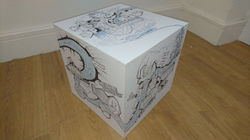Studio E.A.R.T.H presents:
CRAIG HIGGINS
MANIFESTO/DESCRIPTION
Can architecture help Paisley re-discover its once vital river, and showcase its potential to generate clean energy for the community?
The threat posed by global climate change have caused a monumental shift in the way we produce energy. Countries all around the world are aiming to lower their carbon emissions and use renewable energy production and, due to its geography, Scotland is perfectly suited to become a world leader in renewable wind and water generation. Recent legislation has seen feed in tariffs offered to much smaller scale hydro-power schemes. This has seen a race to build many small generation schemes around the country in what has been described as a modern Scottish ‘gold rush’.
This potential for renewable energy generation in Scotland’s many rivers and burns raises the issue of noisy and obtrusive installations popping up around our beautiful landscapes. This has been a very public issue with the many wind turbines that have appeared in recent times. The imposition of these intimidating structures on local communities with little to no meaningful consultation has created tension between energy companies and the communities they are supposed to help.
This thesis proposes that by involving the community in the process of designing and implementing small scale hydro schemes will create a much more harmonious relationship between the people of Scotland and renewable energy production. Furthermore, if good architecture and design could alleviate the often intimidating and inhuman scale of industrial energy production, it would be much easier to integrate into the community.
The Scottish town of Paisley, with the powerful White Cart River at its heart, faces a number of issues. There is a lack of public recreational space, and a complete disconnection to the once vital river. Could the implementation of a small hydro-power generation scheme be the key to Paisley’s future?
This thesis will propose the design of a 'Library of Things' on the White Cart River. A library of things is a facility that works exactly the same as a traditional library except it lends everyday items and equipment. It is a growing movement across the world that was born from community activism aimed at tackling inequality in areas of deprivation and poverty. Often temporary and under funded, these new libraries do not yet have a permanent home. This project will propose a new architectural typology for the 'Library of Things' in which the public can come and learn to use the items on display and then borrow them for their own use. The building will utilise the power of the White Cart River to generate energy, and therefore income, for the facility. The aim of this is to showcase the power of renewable energy and re-engage the town with its river. Also, a re-design of both sides of the river will aim to provide an easily accessible walking and cycling route through the centre of the town. The building itself will house the necessary apparatus for hydro power generation combined with space for displaying, demonstrating, and repairing the items being lended. The architecture will aim to inspire interest in renewable energy and showcase water as an amenity, a force, and a spectacle.
 |  |
|---|---|
 |  |
 |  |
 |  |
 |  |
 |  |
 |  |
 |  |
 |  |
 |  |
 |  |
 |  |
 |  |
 |  |
 |  |
 |  |
 |  |
 |  |
 |  |
 |  |
 |  |
 |  |
 |  |
 |  |
 |  |
 |  |
 |  |
P'17